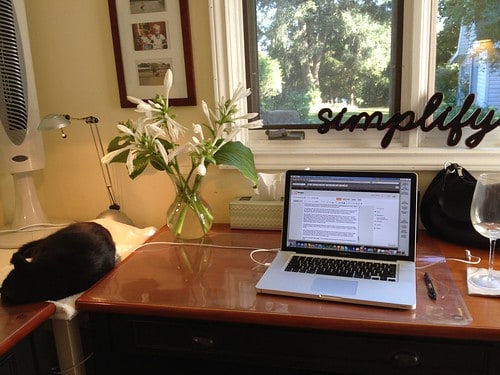When it comes to building a home, you want all the rooms to work efficiently, and a home office is no different. A well-designed office can make all the difference when it comes to productivity. You should strive for setting up an organized and functional space to work. If you’re looking to build a custom home and want a dedicated home office, take the following tips into consideration.
Find the Perfect Location

Image via Flickr by EatLiveGrowPaleo.com
One of the best parts about designing your home is that you can determine where the best spot is to place your home office. Consider your working style as well as the needs of the people who live with you. If you have a job where you’re on the phone frequently, you might want to place the office somewhere away from the center of your home. On the other hand, if your work is solitary, a loft might be a good place for you to work.
Know What You Need
When designing your home office, think about what you need in your work area to help you be more productive. How much storage do you need? Do you need a large desktop? Will you need to use a printer? Once you answer these questions, you can determine how big of a room you need. You can also implement storage areas to eliminate clutter and figure out where you should place the desk. Also take into consideration if you will have clients or customers visiting you since you will need to provide additional seating.
Ensure Ample Outlets
Although most electronics are portable, you’ll have to plug them in at some point. Even if you’re unsure where you want to place your desk in this office, it’s vital to make sure you have plenty of power available. Make sure the space has enough outlets, and consider installing in-the-floor ones to keep wires out of the way. You’ll want some near your desk, so you can connect your computer, printer, and other equipment.
Opt for Soundproofing
Working from home, while convenient, can come with challenges such as unwanted sounds and distractions. Sound waves carry through the air and via construction materials such as wood and metal. The solution is to incorporate sound-dampening materials and objects to help absorb the sound waves. Mount a solid wood door instead of a hollow-core door to block noise from the other side. Install acoustic panels into one or more of the walls to eliminate some exterior noise.
Add Architectural Detail
There’s no rule that states your home office must be sterile, so think about adding texture and other architectural detail. Doing so can make the area feel cavernous and comfortable. Adding paneled walls and a coffered ceiling will give the room personality. You could even place a fireplace in the room to keep you warm during winter months and give the office a focal point.
Get Some Natural Light
Lighting is critical for any home office space, and setting up your office with natural daylight is an excellent way to help you stay energized and more active. In fact, studies have shown that sunlight is good for your mental and physical health. Position your desk near a window to benefit from as much daylight as possible. When working with computers or other screens, make sure you take into account the shift in the sunlight throughout the day and try to minimize the glare. Avoid hanging dark curtains or heavy drapes that might minimize the light.
Provide Quality Lighting
Even if you’re able to give your office space plenty of natural light, you can’t forget about lamps and other light fixtures. Luckily, you don’t need to rely on harsh fluorescent office lighting, but you still need lighting for overcast days and evenings. Creating the right ambiance in a home office is vital, so consider softening harsh light with pendant lighting. These types of lights can illuminate the room without making it feel too cluttered.
Select Practical Flooring
You might not think about what type of flooring you should have in your home office, but don’t forget about this design feature. Engineered wood or laminate flooring are quality options, especially if you have a rolling desk chair. If you prefer to have carpeting, you’ll likely need a plastic desk mat so you can easily move the chair. This mat can also prevent indentations from forming within the carpeting. You can add some visual interest to the room as well by adding a rug or runner, but make sure it has a smooth texture and is dense in pile.
Think About the Color
Your home office is a place you’ll likely spend much of your weekday in, so think about surrounding yourself with colors that motivate and inspire you. You can pair a neutral color with a splash of vibrant color to liven up the area. Green is a color that can help you focus, while yellow represents cheerfulness and optimism. It’s best to stay away from painting the entire area in bold colors such as red or dark purple, particularly because they can be distracting and prevent you from working efficiently.
Improve Ventilation
Poor indoor air quality can cause short- and long-term issues. Short-term nose and eye irritation or long-term respiratory issues can affect your overall health, so it’s best to improve the air quality before it even becomes an issue. Consider installing a mechanical ventilation system, such as an energy recovery ventilator, that swaps out polluted indoor air with fresh outdoor air. During the colder months, use a whole-home or single-room dehumidifier to reduce mold potential.
Contact Steiner Homes Today!
As a family-owned business, Steiner Homes knows how important the home-building process is. Many of the high-quality features offered by other builders come standard with us, so you can outfit your home office with plenty of amenities. We also let you make certain room size adjustments to our standard floor plans. If you’re ready to build a home in northwest Indiana and have it include your perfect office space, contact us today and let us help you make your dreams a reality.

